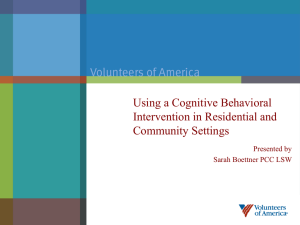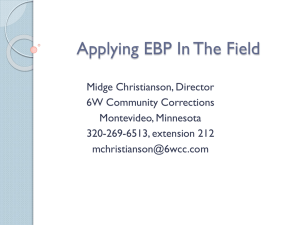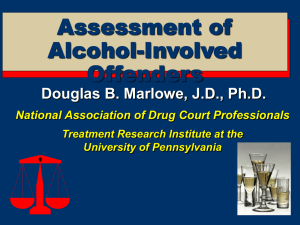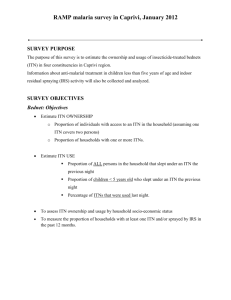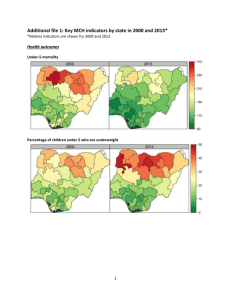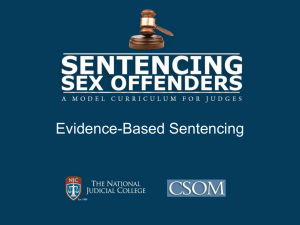6. Enhanced Services for Individuals with Criminogenic Risk Factors
advertisement
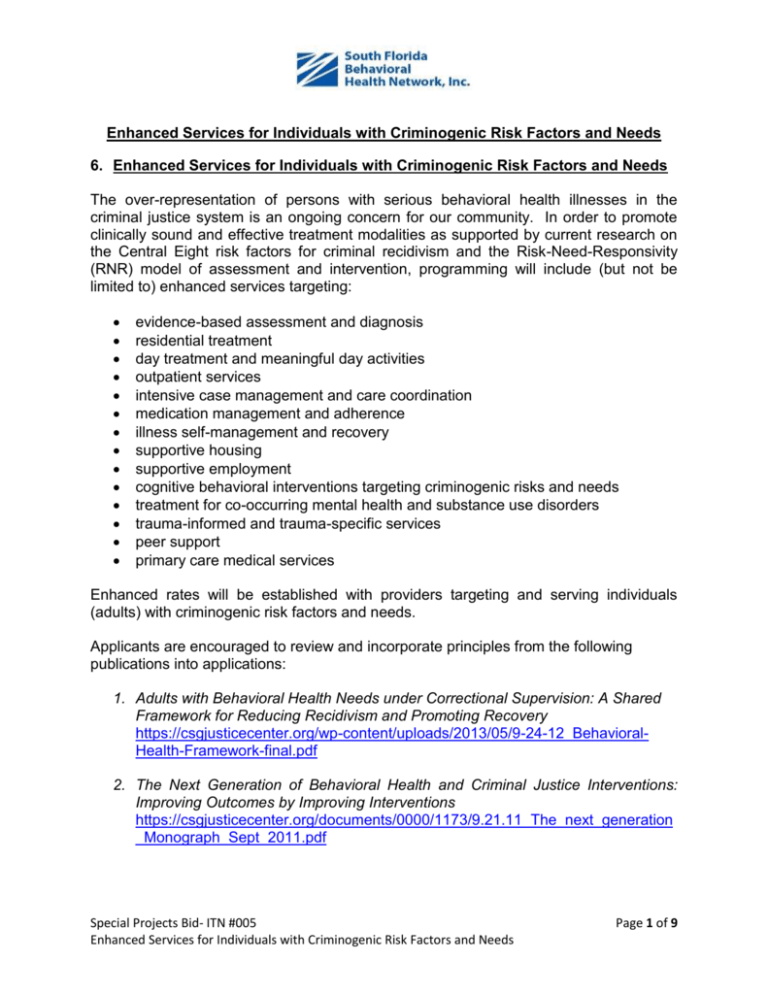
Enhanced Services for Individuals with Criminogenic Risk Factors and Needs 6. Enhanced Services for Individuals with Criminogenic Risk Factors and Needs The over-representation of persons with serious behavioral health illnesses in the criminal justice system is an ongoing concern for our community. In order to promote clinically sound and effective treatment modalities as supported by current research on the Central Eight risk factors for criminal recidivism and the Risk-Need-Responsivity (RNR) model of assessment and intervention, programming will include (but not be limited to) enhanced services targeting: evidence-based assessment and diagnosis residential treatment day treatment and meaningful day activities outpatient services intensive case management and care coordination medication management and adherence illness self-management and recovery supportive housing supportive employment cognitive behavioral interventions targeting criminogenic risks and needs treatment for co-occurring mental health and substance use disorders trauma-informed and trauma-specific services peer support primary care medical services Enhanced rates will be established with providers targeting and serving individuals (adults) with criminogenic risk factors and needs. Applicants are encouraged to review and incorporate principles from the following publications into applications: 1. Adults with Behavioral Health Needs under Correctional Supervision: A Shared Framework for Reducing Recidivism and Promoting Recovery https://csgjusticecenter.org/wp-content/uploads/2013/05/9-24-12_BehavioralHealth-Framework-final.pdf 2. The Next Generation of Behavioral Health and Criminal Justice Interventions: Improving Outcomes by Improving Interventions https://csgjusticecenter.org/documents/0000/1173/9.21.11_The_next_generation _Monograph_Sept_2011.pdf Special Projects Bid- ITN #005 Enhanced Services for Individuals with Criminogenic Risk Factors and Needs Page 1 of 9 Providers will need to provide: Assessment of criminogenic risks and needs: The Provider will either use the results of a completed standardized assessment from the referral source or administer a standardized assessment, approved by SFBHN, to identify criminogenic risk factors and needs, as well as individual strengths and vulnerabilities. Assessments will be completed upon program admission and at regular intervals over the course of treatment to identify changes in risks and needs over time. Results of these assessments shall be incorporated into individualized treatment plans and case management strategies. Medication management and adherence: Consumers will be provided medication management. Therapeutic and Case Management services will support and assist in skill building associated with medication education and compliance, empowering consumers to communicate with their doctors regarding side effects and other treatment-related adverse events, and education regarding coping strategies and health behaviors aimed at maximizing therapeutic outcomes. Consumers will also be assisted in identify primary care needs and Case Management will link consumers with PCP’s and follow up treatment as necessary. Criminogenic risk reduction: Staff will receive training regarding risk factors and needs associated with criminal justice system involvement, as well as interventions designed to reduce risk and promote successful community integration and functioning. The goal will be to reduce maladaptive patterns of thinking and behavior associated with criminal recidivism, while improving psychiatric stability, recovery, and healthy community engagement. Peer Support, Day Treatment, Individual and Group Therapies (including cognitivebehavioral interventions), and Case Management will assist with the development of problem solving skills, anger management, providing access to recreational and leisure activities, and establishment of positive social support networks and interpersonal relationships. Assistance with employment readiness, volunteering, and school will also be provided. Addiction risk reduction: All consumers will be assessed for substance use disorder treatment needs at the point of Intake. Treatment planning for substance use disorders will include goals related to reducing addictive behaviors and developing healthy coping skills to maintain abstinence and minimize risk of relapse. Addiction risk reduction goals and interventions will be integrated into consumers’ overall treatment plans. Trauma risk assessment and trauma specific services: At Intake, all consumers will be assessed for any traumatic events and associated treatment needs. Trauma specific services will be provided for individuals with histories of traumatic events. Special Projects Bid- ITN #005 Enhanced Services for Individuals with Criminogenic Risk Factors and Needs Page 2 of 9 Peer support: Ensure all consumers have the opportunity to develop meaningful peer support relationships that provide one-on-one, real-world assistance, advocacy, and encouragement aimed at fostering a foundation for recovery. Criminal justice in-reach and transition support: Provider will be required to develop relationships with key law enforcement and correctional stakeholders to ensure timely access to care and minimal disruption in services for consumers who come into contact with the criminal justice system, as well as transition assistance for consumers reentering the community from the criminal justice system. This may include providing assessment and other support services to consumers while incarcerated. Provider will also be required to assist consumers in complying with court requirements including attending hearings, developing treatment plans and service recommendations, staffing cases with Jail Diversion Program staff, and providing reports to the courts. Social disadvantage risk reduction: Provider will ensure that basic needs of the consumers are met, which are paramount to ensuring effective interventions in treatment including housing. Outcome Management: Providers will track outcomes specific to this population including admissions to and length of stay in crisis and acute care treatment settings; rates of arrest and incarceration for new criminal offenses; days incarcerated; rates of stable housing and transitions to independent housing; and consumer satisfaction. Estimated Cost: Outpatient Services/Aftercare/Day Treatment - $300,000 Medical Services - $161,600 Residential Services - $581,080 Case Management - $48,000 Supportive Housing - $204,218 Incidentals - $40,000 Trauma Services - $200,000 *Services to include Peer Support Total projected funding for this project: $1,534,898.00 6.1 Page limitation clause as referenced in Section II, paragraph 9, Format Please be as thorough as possible in your response. Limit your response to a ten (10) page narrative for the first covered service applied for and limit your narrative response to five (5) pages for each additional covered service applied for. Special Projects Bid- ITN #005 Enhanced Services for Individuals with Criminogenic Risk Factors and Needs Page 3 of 9 The page limit exclude budgets, timelines, copies of licenses/certifications, and any other supporting documentation you may submit as part of the application as referenced in the narrative. Budgets, timelines, copies of licenses/certifications, and any other supporting documentation referenced in the narrative responses must be labeled and numbered accordingly. 6.2: NARRATIVE Organization’s Legal Name:_____________________________________________ I. Total Funding Requested: ___________________________ Outpatient Services/Aftercare/Day Treatment: $ __________________ Medical Services: $ _____________________ Residential Services: $ _____________________ Case Management: $ _____________________ Supportive Housing: $ _____________________ Incidental Expenses: $ _____________________ Trauma Services: $ _____________________ Grand Total $ _____________________ II. Briefly describe your organization and its current infrastructure, addressing your readiness and capability to acquire an additional program/service. III. Projected Unduplicated Number of Individuals to be served (SAMH, Local Match funding only if applicable to the contract):______________ IV. History and experience providing the services to the proposed target population. Provide information about the demographic profile of the population your agency serves. Special Projects Bid- ITN #005 Enhanced Services for Individuals with Criminogenic Risk Factors and Needs Page 4 of 9 V. VI. VII. VIII. History and experience working with stakeholders in the criminal justice system (e.g., law enforcement agencies, correctional facilities, courts, probation) Identify the service site address. Identify the client-to-counselor ratio Number of FTE’s that provide direct services by covered service: Covered service name IX. Supervisory Support Total FTE’s Minimum staffing qualifications for each type of service delivery position. Covered service name X. Direct Service Direct Service Supervisory Identification and Engagement Strategies: 1. Identify the major referral sources for persons receiving services. 2. Describe the organization’s specific individual identification and engagement strategies applicable to the Program. 3. Identify the evidence-based approaches for the target population served as recognized by SAMHSA’s National Registry of Evidence-based Programs (EBP) and Practices (NREPP). Target Population Adults with Criminogenic Risks and Needs Evidence-based Practice 1. 2. 3. Special Projects Bid- ITN #005 Enhanced Services for Individuals with Criminogenic Risk Factors and Needs Page 5 of 9 4. Explain how you will ensure adherence to each of the EBP models 5. List each evidence-based practice utilized and the fidelity tool used for each. Identify the Fidelity Tool used. If no fidelity tool is available, describe how fidelity will be ensured Evidence-based Practice 1. 2. 3. 4. 6. Describe why your agency selected the EBP(s) identified above to serve the target population. 7. Please provide the name and title of the staff that are certified in the evidence-based practice. Name Title EBP 1. 2. 3. 4. XI. Service Delivery Strategies: Describe the organization’s specific service delivery strategies for providing individual services/care under the Program. This description should address the service delivery strategies as applied to the program that will be used, the services made available, individual assessment of needs and re-evaluation of those needs, and the processes used to match individuals to services and ensure that services are consistent with the their recovery and resiliency needs. 1. Describe the specific services that will be made available. 2. Admission criteria. 3. Discharge criteria. Special Projects Bid- ITN #005 Enhanced Services for Individuals with Criminogenic Risk Factors and Needs Page 6 of 9 4. Average length of participation for persons served. 5. Describe the means and the frequency by which individual needs will be evaluated and re-evaluated throughout the episode of care. 6. Describe the processes employed to match individuals to services and ensure that services are consistent with the individuals’ individual recovery and resiliency needs. 7. Specify the nature and role of Incidental Expense funding and any categorical funding, if applicable and allocated, used in support consumer participation in services. XII. Using your agency’s current client retention rates and other measures you currently utilize, as a baseline, propose performance measures and outcomes that support the objectives of the special project. The proposed measures will be incorporated as contractual requirement if this project is funded. XIII. Success Indicator and Measure Methodology: Describe how your agency will test to confirm the success of the project based on the proposed measures provided above (who, how, when/frequency). Include timeframes for reporting results to SFBHN. XIV. Continuing Care Strategies: Identify the major continuing strategies for individuals completing services through this program. Continuing care strategy descriptions should address placement and referral activities specific to processes by which individuals are prepared for and transitioned to continuing care services; the major continuing care strategies, best practice models, community housing/living options, primary health care needs, natural supports, and/or other alternatives for individuals completing services in this Activity (within the organization and within the community system of care). 1. Describe the processes by which individuals are prepared for and transitioned to continuing care services. 2. Describe the major continuing care strategies, best practice models, and community housing/living options, primary health care needs, natural supports, and/or other alternatives for individuals completing services in this program (within the organization and within the community system of care). Special Projects Bid- ITN #005 Enhanced Services for Individuals with Criminogenic Risk Factors and Needs Page 7 of 9 3. Provide a description of any activity funded covered service and related services utilized to affect the transition. 4. Describe how Incidental Expense funds are used to support individual transitions. XV. Please indicate why your agency and proposed program should be selected to receive the funding for this program. XVI. Provide a timeline for the implementation of the service identifying key activities, milestones, deliverables and responsible staff – This attachment will not counted toward the suggested page limitation. The attachment must be labeled and numbered accordingly. XVII. Budget: All costs associated with services proposed in this bid must be reasonable, necessary and allowable, and relate to the program/coalition in compliance with both the Cost Principles for Nonprofit Organizations: OMB 2 CFR Chapter I, Chapter 2, Part et.al. Uniform Administrative Requirements, Cost Principles and Audit Requirements for Federal Awards, and The Community Substance Abuse and Mental Health Services Financial Rules specified in Chapter 65E-14021(5)(e), Florida Administrative Code. Applicants will submit a one (1) year, 12 month budget for related expenditures as outlined in this bid, consistent with the start times reflected in the timelines for implementation of the activities. All proposed costs must be in accordance with the Department of Financial Services Reference Guide for State Expenditures, February 2011, which may be located at: http://www.flrules.org/Gateway/reference.asp?No=Ref-04201 The budget forms (“Fiscal Forms 15-16v.5”), which are incorporated herein by reference, have been posted on the SFBHN website as a separate document to this bid. The budget must be submitted along with your application. A detailed (using complete sentences) budget justification narrative is required. Indicate what current resource will be allocated to support the software provided through this application. It must clearly link all budget items to program activities and justify the proposed costs. The page limitation does not apply to the budget(s). XVIII. Licensing, Programmatic, and Administrative Requirements: Special Projects Bid- ITN #005 Enhanced Services for Individuals with Criminogenic Risk Factors and Needs Page 8 of 9 It is the selected applicant’s responsibility to ensure that the appropriate licenses/certifications, as appropriate, are secured prior to the implementation of any project selected for funding. Attach a copy of the appropriate license/certifications or a copy of the application(s) submitted to the licensing/certification authority (e.g., DCF or AHCA). If an applicant does not currently have the required license and/or certification required for the program/service applied for, a plan and timeline for obtaining the required license and/or certification must be submitted with the application(s). Failure to do so will be deemed non-responsive with a critical flaw and the application for that service will not be considered for funding. The plan will be reviewed by SFBHN’s staff who in their sole discussion will determine if the timeframe to obtain the license and implement the program is reasonable and therefore allow the application to be considered for funding. Special Projects Bid- ITN #005 Enhanced Services for Individuals with Criminogenic Risk Factors and Needs Page 9 of 9


